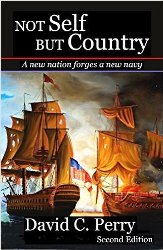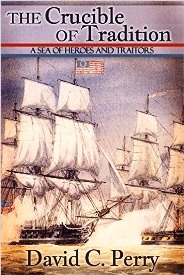 Pirates and Privateers Pirates and Privateers
The History of Maritime
Piracy
Cindy Vallar, Editor
& Reviewer
P.O. Box 425,
Keller, TX 76244-0425
    
Books for Adults ~ Nautical Fiction
Not
Self But Country
The
Crucible of Tradition

Not Self But Country: A New Nation Forges a New Navy
By David C. Perry
David Perry, 2014, e-book ISBN 978-2940045717571, US
$2.99
reviewed by Irwin Bryan
This is the first volume of a
new naval fiction series with the American
Navy as the subject. This book is full of
action that is exciting to read and
accurately portrayed. Mr. Perry writes as
if he himself has stood on the quarterdeck
in the midst of battle!
There are a number of historical
characters introduced to us, some as young
men before being inserted later in the
story, and others are presented as events
take place. We encounter Robert Morris,
the administrative and financial Father of
the Navy; John Barry as master of a
merchant ship before his naval and
privateer exploits; Richard Dale who is
unsure where his loyalties and naval
service should be; and John Paul Jones as
mate and passenger aboard merchant
vessels.
Then there are also characters needed to
serve other roles in the narrative. These
include midshipmen and lieutenants on both
Continental Navy and Royal Navy vessels,
as well as those who serve as warrant
officers and sailors. This makes meeting
and keeping track of everyone difficult at
times. The e-book has a list of characters
after the narrative, but I had already
finished the book before I knew it was
there!
Anyone familiar with the history of the
Continental Navy knows there isn’t much
action that takes place during the
Revolutionary War. Worse still are
historical events, such as the raid on
Nassau and the Battle of Block Island,
which are not complimentary to the
commodores and captains who participate or
even exciting actions in any way. This
makes writing naval fiction about the
fledgling navy difficult to say the least.
Mr. Perry chooses to just mention these
events in historical context and writes
instead of the early South Carolina Navy
for action worthy of presentation in his
book.
The USS Lexington is the first
Continental naval vessel Richard Dale
serves aboard, before it is captured and
he is taken to Mill Prison. He is able to
escape, but is unable to make it out of
England before being recaptured. Refusing
to sit out the war, he again escapes and
is able to get to France where he presents
himself to John Paul Jones and is
appointed a lieutenant on the Bonhomme
Richard.
Before continuing the narrative, I need to
comment on Perry’s editing of John Paul
Jones’s story. The way nothing
controversial is mentioned in his early
history, and his raid on the home of his
childhood lord is missing from the
narrative, seem almost Orwellian when you
realize only his good qualities are
discussed and nothing negative to
potential British readers is included in
the story beyond his historical victory.
At the same time, I wonder why the
successful action between USS Ranger and
HMS Drake is excluded. Hopefully,
this battle will not appear later in the
series, where history’s chronological
order is sacrificed to provide a more
entertaining book.
Writing about the famous battle between Bonhomme
Richard and HMS Serapis is
yet another problem for Mr. Perry to
contend with. It is a sure bet that many
of his readers are familiar with the
battle and have already even read
fictional accounts in other novels. The
challenge of describing the fight in a way
that grips the readers’ attention and also
matches the historical record is enormous,
but Mr. Perry achieves this with precise
and suspenseful vignettes of several men
on each vessel as the event unfolds.
For a new author to rise to the occasion
the way Mr. Perry has guarantees his
success in the genre and makes readers
want to order his second book in the
series, Crucible of Tradition. I
did and I can’t wait to read it!
Review Copyright ©2015 Irwin Bryan


The Crucible of Tradition: A Sea
of Heroes and Traitors
By David C. Perry
CreateSpace, 2015, print ISBN 978-1511634687, US
$15.95
Available in e-book format
    
reviewed by Irwin Bryan
When I
reviewed Perry’s Not Self But
Country, I was critical of the
battle between BonHomme Richard
and Serapis appearing in the
first book in this series. Yes, I
read the introduction, which clearly
states the series would not be
written in chronological order, but
having read so many other series
(all of which were in chronological
order) I wasn’t able to grasp the
full meaning of this statement.
Realizing the story
of America’s navy is not just
about ships and battles, Perry
wisely presents individual
commanders’ stories, beginning
with the events that first bring
these men to America or lead them
to working on ships through to
their experiences aboard warships
that help to establish the navy’s
traditions of victory. This allows
the author to include actions that
take place before the colonies are
ready to declare their
independence from Britain.
The Crucible of
Tradition, like the first
book, begins in the 1750s. This
time, we meet young John Barry in
Ireland as his family is evicted
from their home in Ballysampson
and goes to stay with his uncle.
Barry is secretly taught to read
and do his sums at his uncle’s
home since the British frown on
the Irish being educated. When he
is nine years old, he becomes a
cabin boy aboard his uncle’s ship
and begins his training and life
as a mariner.
As
the colonies
prepare for armed
conflict in March
1776, Barry
attends a meeting
in Philadelphia
and accepts a
commission to
command the
brigantine Lexington.
He is charged with
keeping the
approaches of the
Delaware Bay clear
of British
cruisers. When he
sails downriver
the next month,
the Revolutionary
War begins in
earnest along the
colonies’ coastal
waters.
Off the island of
Minorca, Spain in 1764, Barry is
now the first mate and his ship is
being chased by a xebec-rigged
pirate vessel. Both fire their
cannons in an attempt to damage
the other’s sails and rigging.
Barry’s captain hopes to sail
close to the island fortress and
reach the protection of their big
guns.
On a nearby headland a young
Minorcan, Jorge Farragut, watches
the exciting battle and dreams of
some day chasing pirates with his
own ship. In
June 1778,
Lieutenant Jorge
Farragut and two
new midshipmen,
including John
Mayrant, are
aboard the South
Carolina Navy
vessel Notre
Dame. On a
cruise in waters
near Bermuda, Notre
Dame battles
a pirate vessel.
In the struggle
that follows, John
Mayrant’s courage
is tested when the
exciting encounter
shifts from
cannons to swords.
As many other
naval fiction
authors have done,
reading about the
midshipmen’s
lessons helps to
educate less
knowledgeable
readers about the
ship and the way
it’s rigged.
In the American
colonies the Royal Navy
aggressively enforces the taxation
of goods by searching and seizing
shipping in coastal waterways. One
particularly bothersome vessel is
the British schooner Gaspee,
which operates in the waters off
Newport, Rhode Island. In June
1772, while chasing the Hannah,
the Gaspee runs hard
aground. Incensed at the actions
of this British ship and her
captain, a group of merchants and
sailors row out to the helpless
vessel to seek revenge.
John Paul Jones’s
life story continues with an
unfortunate episode that occurs
while he is master of a vessel at
Tobago in 1773. When one member of
his mutinous crew confronts him
with a weapon, John kills the man
in self-defense. With little faith
in the local legal system his
advisors encourage him to leave
the island and his ship.
In Newport, Rhode
Island, Lieutenant John Paul Jones
of the Continental Navy takes
command of the sloop Providence.
Joining him is Midshipman
Nathaniel Fanning. Their first
action comes when they encounter
HMS Lilac. Just when they
think they’ll capture her, she
rounds a headland where HM Frigate
Cerebus is at anchor. Now
Jones and Providence become
the prey.
In September 1779, we
find Commodore Jones and his crew
aboard the captured Serapis.
Captain Landais of Alliance informs
Jones that he will not obey the
Commodore unless it suits him.
Once they arrive in France,
Landais is removed from command to
face a court-martial, but he is
not kept as a prisoner. While
Jones travels to Paris to meet
with Benjamin Franklin, Landais
resumes command of Alliance.
To prevent him from leaving
France, Jones may have to fight Alliance
with help from his French
allies.
Throughout this
second novel, Perry writes in a
way that brings the characters to
life for the reader. While the
actions that take place are
shorter and less intense than the
struggle between BonHomme
Richard and HMS Serapis,
the descriptions and dialogue
bring readers into the story
until, with swords in hand, we
repel boarders on the slippery
deck!
That’s a good read!
Review
Copyright ©2016 Irwin Bryan


Click to contact me
Background image compliments
of Anke's Graphics |


